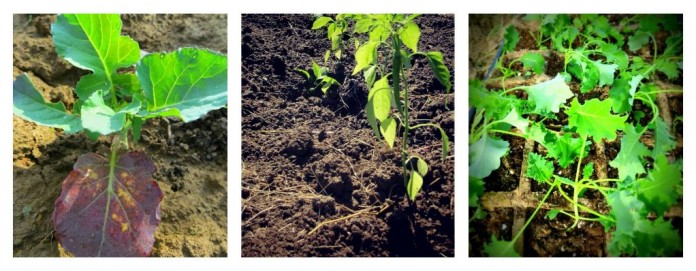Whether you started seeds yourself or purchased vegetable seedlings at the store, now is the time to transplant seedlings in your garden.
10 simple steps to transplant
- Seedlings should be hardened-off, well-fed and watered before transplanting.
- Prepare a weed-free surface. Loosen and aerate garden soil by tilling or hoeing.
- Dig a hole large enough for seedling.
- Carefully remove seedling from its container. Try not to disturb the roots.
- Set seedling in hole level with soil surface. The exception is tomato seedlings, which can be transplanted a bit deeper.
- Feed seedling to kick start growth. I transplant each seedling with a hefty handful of compost. If you don’t make compost, purchase specially formulated fertilizer for transplanting.
- Surround seedling with displaced soil.
- Water seedling thoroughly.
- Mulch seedling to maintain soil moisture and regulate temperature.
- Keep area weed-free.
Top 3 tips for successful transplanting

If you buy seedlings remember biggest doesn’t always mean best. Look for healthy and consistent leaf color. The roots should be deep, long, white and fibrous. The stem should be thick and strong. The growing medium should be held together by tight tangled roots. Do not choose leggy seedlings; too long of stem means the seedling was starved for light.
Hardening off is important. Don’t skip this step. Store bought seedlings are typically hardened off in the garden center, but seedlings you start need to be acclimated to the natural environment before transplanting.
Hardening takes 1-2 weeks. You can move seedlings to a cold frame for a week and then set in the garden an additional week. Or set seedlings out during warm daytime temps and bring them in at night.
Timing is everything. Frost-free dates and warm and cool weather crop temperature requirements for your growing zone are good guidelines. I also consider last season’s planting dates and the weather forecast.
Overcast days are great days to plant because cloud coverage reduces the probability of sun-scorching tender plants.
More spring gardening posts:
- The many faces of mulch: Choosing the best for your lawn and garden May 8, 2015
- How to plant a square foot garden May 7, 2015
- If weeds could talk April 24, 2015
- Sunlight requirements for growing vegetables April 10, 2015
- How to create a pet-friendly garden March 24, 2015
- How to start a container garden Feb. 10, 2015











